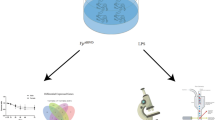Abstract
To clarify factors reducing the motility and fertility of cryopreserved spermatozoa of the Japanese pearl oyster Pinctada fucata martensii, the structure of spermatozoa before and after cryopreservation was observed by scanning electron microscopy. Testicular spermatozoa were diluted with cryopreservation diluent (10% methanol+18% fetal bovine serum+72% sea water), and dispensed into 0.25-mL straws. The straws were cooled at a rate of approximately −20 °C/min to −50°C, and subsequently immersed in liquid nitrogen. Percentage motility of spermatozoa before cryopreservation was 69.9±4.2%, and that of cryopreserved spermatozoa was 24.0±1.8%, respectively. In cryopreserved spermatozoa, the percentage that lacked or had a deformed flagellum was 56.6±3.9%, while in fresh spermatozoa this was 8.7±2.0%. In cryopreserved spermatozoa, the percentage of deformed acrosomes was 76.6±5.2%, while in fresh spermatozoa this was only 0.9±0.3%. Cryopreserved spermatozoa with a normal acrosome and flagellum were only 15.4±3.5% of those in fresh spermatozoa. These results indicate that lesion of the flagellum and deformation of the acrosome occurred through the cryopreservation procedure, and both types of damage lead to loss of the motility and fertility in thawed spermatozoa.
Similar content being viewed by others

References
Kurokawa T, Suzuki T, Okauchi M, Miwa T, Nagai K, Nakamura K, Honjo T, Nakajima K, Ashida K, Funakoshi S. Experimental infections of a disease causing mass mortalities of Japanese pearl oyster Pinctada fucata martensii by tissue transplantation and cohabitation. Nippon Suisan Gakkaishi 1999; 65: 241–251.
Morizane T, Takimoto S, Nishikawa S, Matsuyama N, Tyohno K, Uemura S, Fujita Y, Yamashita H, Kawakami H, Koizumi Y, Uchimura Y, Ichikawa M. Mass mortalities of Japanese pearl oyster in Uwa Sea, Ehime in 1997–1999. Fish Pathol. 2001; 36: 207–216.
Okamoto C, Komaru A, Hayashi M, Aoki H, Isowa K. Variation of shell-closing strength among several families in pearl oyster, Pinctada fucata martensii. Aquacult. Sci. 2006; 54: 525–529.
Kawamoto T, Narita T, Isowa K, Aoki H, Hayashi M, Komaru A, Ohta H. Effects of cryopreservation methods on cryopreserved motility of spermatozoa from the Japanese pearl oyster, Pinctada fucata martensii. Cryobiology 2007; 54: 19–26.
Narita T, Kawamoto T, Isowa K, Aoki H, Hayashi M, Komaru A, Ohta H. Fertility of cryopreservation spermatozoa of the Japanese pearl oyster, Pinctada fucata martensii. Aquaculture 2008; 275: 178–181.
Clark WH Jr, Kleeve MG, Yudin AI. An acrosome reaction in natantian sperm. J. Exp. Zool. 1981; 218: 279–291.
Yanagimachi R. Mammalian Fertilization. In: Knobil, E, Neill, JD (eds). The Physiology of Reproduction, Vol. 2 Raven Press, New York, NY 1994.
Honma Y. Pisces. In: Ishida K, Iwasawa H (eds). The Biomechanism of Gonad. Ai-Pi-Si press, Tokyo. 1990 (in Japanese).
Suquet M, Dreanno C, Fauvel C, Cosson J, Billard R. Cryopreservation of sperm in marine fish. Aquacult. Res. 2000; 31: 231–243.
Chao NH, Liao IC. Cryopreservation of finfish and shellfish gametes and embryos. Aquaculture 2001; 197: 161–189.
Kurokura H, Yagi N, Hirano R. Studies on cryopreservation of sea urchin spermatozoa. Suisanzoshoku 1989; 37: 215–219.
Kurokura H, Namba K, Ishikawa K. Lesions of spermatozoa by cryopreservation in oyster Crassostrea gigas. Nippon Suisan Gakkaishi 1990; 56: 1803–1806.
Ohta H, Kawamoto T, Isowa K, Aoki H, Hayashi M, Narita T, Komaru A. Motility of spermatozoa obtained from testis of the Japanese pearl oyster Pinctada fucata martensii. Fish Sci. 2007; 73: 107–111.
Matsunaga H, Iwata N, Kurokura H, Hirano R. A preliminary study about cryopreservation of abalone sperm. J. Fac. Appl. Biol. Sci. Hiroshima Univ. 1983; 22: 135–139.
Bury NR, Olive PJW. Ultrastructure observation on membrane changes associated with cryopreserved spermatozoa of two polychaete species and subsequent mobility induced by quinacrine. Invert. Reprod. Dev. 1993; 23: 139–150.
Fahy GM, Lilley TH, Linsdell H, Douglas St JM, Merryman HT. Cryoprotectant toxicity and cryoprotectant toxicity reduction: In search of molecular mechanisms. Cryobiology 1990; 27: 247–268.
Dan JC. The acrosome reaction. Internat. Rev. Cytol. 1956; 5: 365–393.
Gwo JC. Cryopreservation of aquatic invertebrate semen: a review. Aquacult. Res. 2000; 31: 259–271.
Author information
Authors and Affiliations
Corresponding author
Rights and permissions
About this article
Cite this article
Narita, T., Kawamoto, T., Isowa, K. et al. Effects of cryopreservation on sperm structure in Japanese pearl osyter Pinctada fucata martensii . Fish Sci 74, 1069–1074 (2008). https://doi.org/10.1111/j.1444-2906.2008.01626.x
Received:
Accepted:
Issue Date:
DOI: https://doi.org/10.1111/j.1444-2906.2008.01626.x



